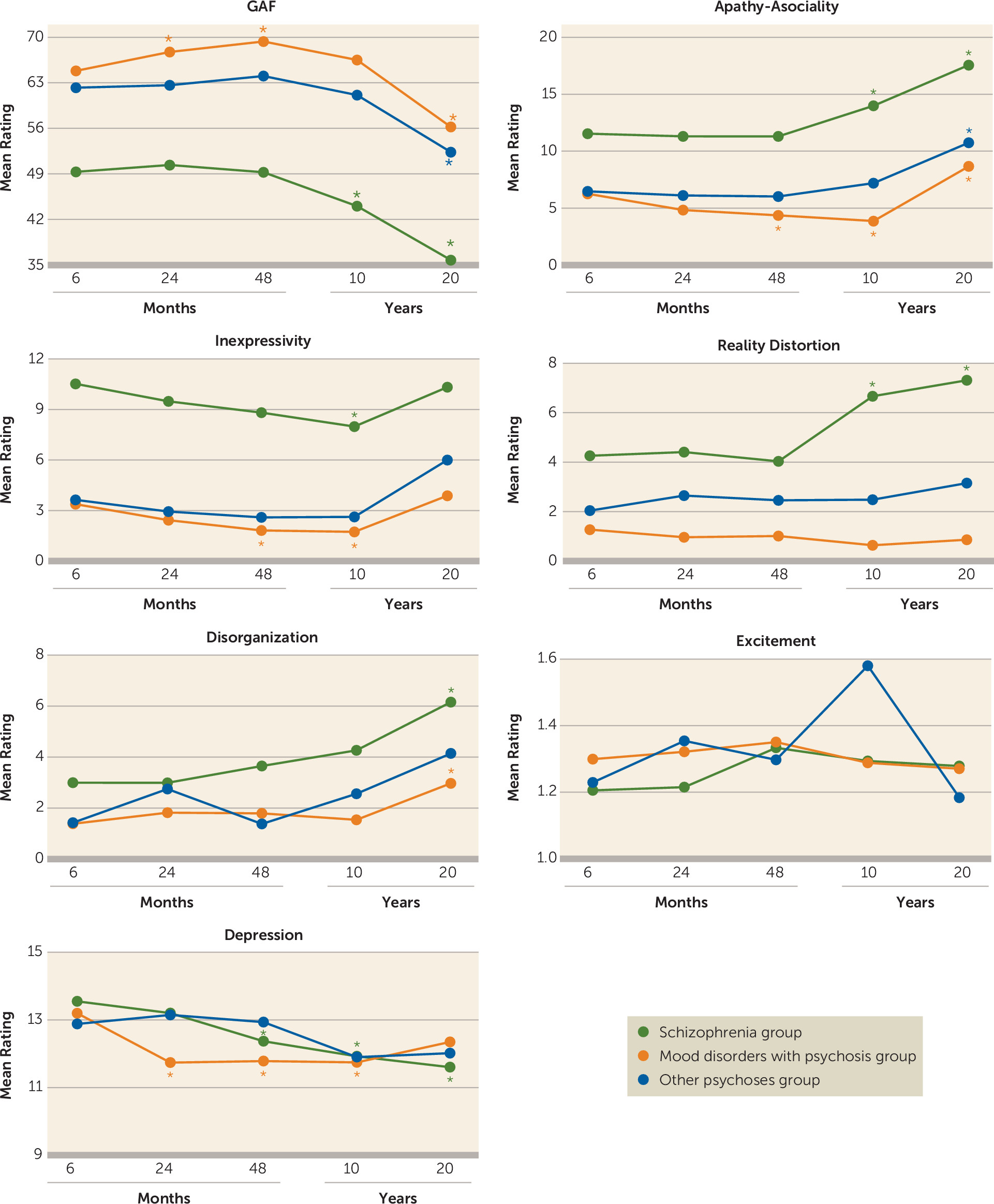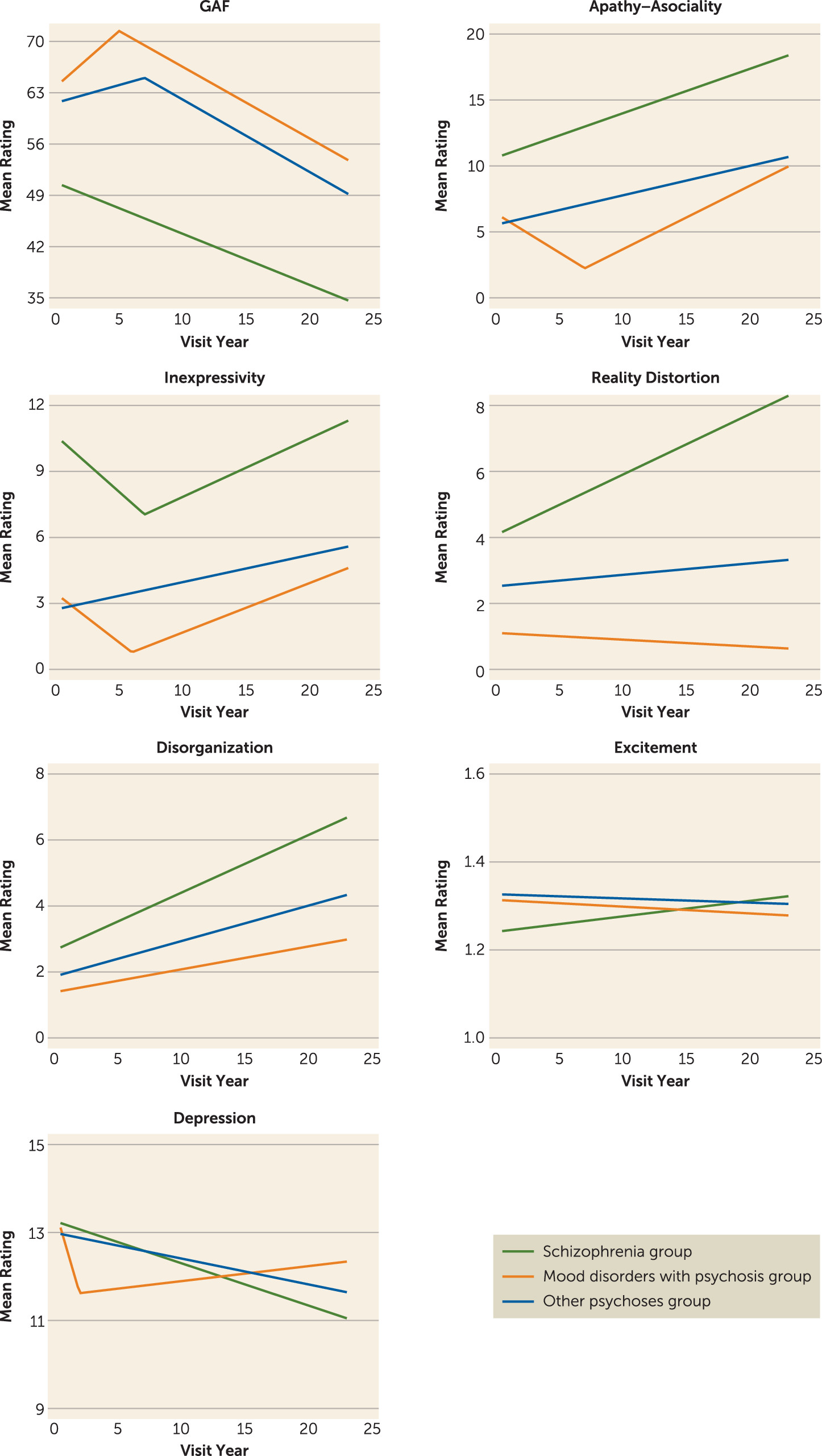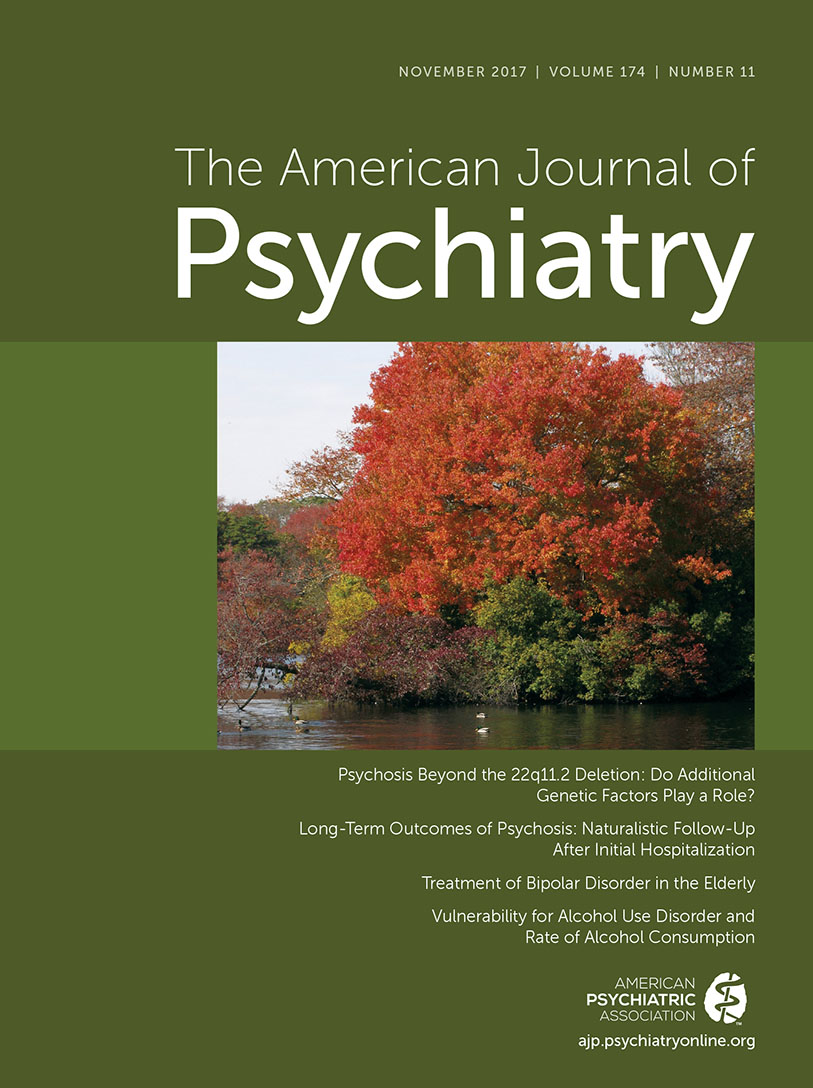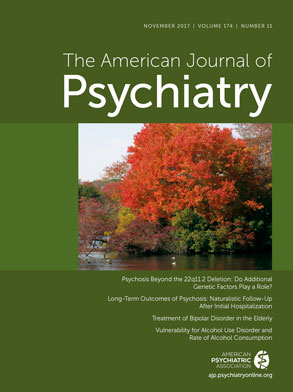Declining Clinical Course of Psychotic Disorders Over the Two Decades Following First Hospitalization: Evidence From the Suffolk County Mental Health Project
Abstract
Objective:
Method:
Results:
Conclusions:
Method
Participants
| Measure | Follow-Up Cohort (N=373) | Nonparticipants (N=176) | ||
|---|---|---|---|---|
| Demographic characteristics | N | % | N | % |
| Male | 222 | 59.5 | 97 | 55.1 |
| Age <28 years | 195 | 52.3 | 87 | 49.4 |
| Blue-collar household | 165 | 44.2 | 75 | 42.6 |
| Caucasianb | 290 | 77.7 | 119 | 67.6 |
| Research diagnosis (last available) | ||||
| Schizophrenia spectrum disorder | 175 | 46.9 | 73 | 41.5 |
| Bipolar I disorder with psychosis | 94 | 25.2 | 41 | 23.3 |
| Major depressive disorder with psychosis | 43 | 11.5 | 25 | 14.2 |
| Substance-induced psychosis | 25 | 6.7 | 16 | 9.1 |
| Other/undetermined psychosis | 36 | 9.7 | 21 | 11.9 |
| Baseline ratings | Mean | SD | Mean | SD |
| GAF (best month in year before hospitalization) | 58.17 | 14.25 | 59.98 | 14.87 |
| Apathy-asociality | 9.38 | 7.61 | 8.90 | 6.21 |
| Inexpressivity | 7.32 | 8.08 | 6.28 | 6.98 |
| Reality distortionb | 10.73 | 8.71 | 12.78 | 10.39 |
| Disorganization | 6.89 | 6.52 | 6.32 | 5.89 |
| Depression | 17.52 | 5.38 | 17.22 | 4.93 |
| Mania/excitement | 1.66 | 1.16 | 1.53 | 1.07 |
Measures
Data Analysis
Results
Description of Clinical Course
| Outcome Measure and Assessment Point | Schizophrenia | Bipolar Disorder With Psychosis | Psychotic Depression | Substance-Induced Psychosis | Other/Undetermined | |||||
|---|---|---|---|---|---|---|---|---|---|---|
| Mean | SD | Mean | SD | Mean | SD | Mean | SD | Mean | SD | |
| GAF | ||||||||||
| Baseline | 52.65 | 14.17 | 67.83 | 9.44 | 60.30 | 12.99 | 57.68 | 11.92 | 57.53 | 14.64 |
| 6 months | 49.34 | 13.18 | 66.37 | 11.90 | 61.45 | 13.94 | 61.74 | 11.45 | 62.73 | 12.67 |
| 24 months | 50.39 | 12.90 | 69.14 | 10.83 | 64.98 | 12.31 | 64.65 | 11.45 | 60.96 | 14.39 |
| 48 months | 49.27 | 12.21 | 70.05 | 11.81 | 67.93 | 12.03 | 65.05 | 13.06 | 63.13 | 15.10 |
| 10 years | 44.06 | 10.67 | 66.95 | 13.14 | 65.61 | 11.72 | 61.39 | 13.99 | 60.93 | 15.49 |
| 20 years | 35.79 | 10.57 | 57.79 | 16.78 | 52.81 | 16.06 | 53.88 | 16.82 | 51.33 | 19.03 |
| Apathy-asociality | ||||||||||
| Baseline | 12.11 | 7.36 | 4.95 | 5.74 | 10.67 | 7.60 | 8.40 | 5.61 | 6.86 | 8.26 |
| 6 months | 11.55 | 7.92 | 5.23 | 6.05 | 8.51 | 7.87 | 7.35 | 4.98 | 5.69 | 7.11 |
| 24 months | 11.31 | 6.64 | 3.76 | 5.20 | 6.97 | 7.32 | 5.87 | 5.74 | 6.36 | 6.90 |
| 48 months | 11.30 | 6.70 | 3.70 | 4.67 | 5.67 | 6.88 | 4.47 | 4.90 | 7.67 | 7.12 |
| 10 years | 13.99 | 8.14 | 3.53 | 4.75 | 4.60 | 5.77 | 7.87 | 7.96 | 6.62 | 8.13 |
| 20 years | 17.56 | 8.84 | 8.00 | 7.70 | 10.11 | 8.52 | 9.74 | 9.05 | 11.51 | 10.23 |
| Inexpressivity | ||||||||||
| Baseline | 10.22 | 8.39 | 3.86 | 6.10 | 6.60 | 8.43 | 4.28 | 5.70 | 5.28 | 7.23 |
| 6 months | 10.52 | 8.92 | 2.64 | 4.79 | 5.00 | 7.09 | 3.30 | 4.20 | 3.92 | 6.58 |
| 24 months | 9.48 | 8.19 | 1.80 | 2.63 | 3.68 | 5.62 | 3.22 | 5.14 | 2.68 | 4.64 |
| 48 months | 8.82 | 8.82 | 1.61 | 3.15 | 2.24 | 3.66 | 1.53 | 3.22 | 3.72 | 5.30 |
| 10 years | 7.99 | 7.67 | 1.68 | 3.98 | 1.87 | 4.15 | 2.40 | 4.57 | 2.83 | 6.49 |
| 20 years | 10.32 | 10.37 | 3.69 | 5.45 | 4.26 | 7.13 | 4.00 | 6.17 | 7.90 | 11.34 |
| Reality distortion | ||||||||||
| Baseline | 12.54 | 9.36 | 10.77 | 8.87 | 6.23 | 6.00 | 8.40 | 6.89 | 8.83 | 6.05 |
| 6 months | 4.26 | 7.44 | 0.56 | 1.29 | 2.81 | 4.56 | 1.52 | 3.19 | 2.50 | 4.67 |
| 24 months | 4.41 | 6.36 | 0.99 | 3.19 | 0.92 | 2.74 | 1.83 | 3.66 | 3.40 | 6.30 |
| 48 months | 4.03 | 6.67 | 1.05 | 2.78 | 0.94 | 2.52 | 1.53 | 3.01 | 3.44 | 7.96 |
| 10 years | 6.66 | 8.24 | 0.46 | 1.86 | 1.03 | 2.29 | 1.78 | 3.25 | 3.07 | 5.69 |
| 20 years | 7.31 | 9.34 | 0.84 | 2.16 | 0.93 | 2.32 | 2.73 | 4.79 | 3.47 | 5.92 |
| Disorganization | ||||||||||
| Baseline | 7.19 | 7.00 | 8.97 | 6.05 | 1.86 | 2.96 | 5.68 | 5.37 | 6.89 | 6.07 |
| 6 months | 2.99 | 5.14 | 1.61 | 3.00 | 0.89 | 1.37 | 0.70 | 1.15 | 2.08 | 2.64 |
| 24 months | 2.99 | 4.35 | 2.19 | 3.93 | 1.08 | 2.13 | 2.09 | 3.63 | 3.36 | 5.22 |
| 48 months | 3.65 | 4.87 | 2.34 | 4.22 | 0.73 | 1.86 | 0.47 | 1.02 | 2.33 | 3.07 |
| 10 years | 4.27 | 6.00 | 1.79 | 3.74 | 0.94 | 2.45 | 1.29 | 2.24 | 3.64 | 6.20 |
| 20 years | 6.16 | 7.28 | 3.21 | 5.22 | 2.45 | 4.33 | 2.07 | 3.76 | 5.71 | 6.32 |
| Depression | ||||||||||
| Baseline | 17.04 | 5.02 | 16.85 | 5.13 | 22.21 | 5.23 | 16.96 | 5.83 | 16.42 | 5.10 |
| 6 months | 13.55 | 4.03 | 12.13 | 3.35 | 15.51 | 5.51 | 12.70 | 3.97 | 13.04 | 5.08 |
| 24 months | 13.20 | 4.46 | 11.16 | 3.47 | 12.86 | 5.27 | 12.52 | 4.67 | 13.72 | 5.00 |
| 48 months | 10.69 | 3.79 | 9.94 | 3.07 | 12.00 | 5.72 | 10.53 | 3.42 | 11.72 | 5.38 |
| 10 years | 11.92 | 3.76 | 10.99 | 3.47 | 13.35 | 5.10 | 12.55 | 4.27 | 11.37 | 3.25 |
| 20 years | 11.60 | 3.28 | 11.87 | 3.93 | 13.35 | 4.57 | 11.43 | 3.51 | 12.45 | 3.85 |
| Mania/excitement | ||||||||||
| Baseline | 1.49 | 1.00 | 2.13 | 1.39 | 1.07 | 0.34 | 1.96 | 1.34 | 1.78 | 1.22 |
| 6 months | 1.21 | 0.66 | 1.44 | 0.90 | 1.00 | 0.00 | 1.26 | 0.75 | 1.20 | 0.71 |
| 24 months | 1.22 | 0.65 | 1.41 | 0.92 | 1.14 | 0.48 | 1.22 | 0.60 | 1.48 | 1.08 |
| 48 months | 1.33 | 0.68 | 1.47 | 0.96 | 1.12 | 0.42 | 1.21 | 0.54 | 1.39 | 0.78 |
| 10 years | 1.29 | 0.80 | 1.35 | 0.90 | 1.15 | 0.48 | 1.57 | 1.20 | 1.59 | 1.37 |
| 20 years | 1.28 | 0.83 | 1.34 | 0.87 | 1.13 | 0.47 | 1.14 | 0.48 | 1.21 | 0.63 |
| N | % | N | % | N | % | N | % | N | % | |
| Use of antipsychotics | ||||||||||
| Baseline | 152 | 86.9 | 82 | 87.2 | 31 | 72.1 | 15 | 60.0 | 31 | 86.1 |
| 6 months | 148 | 84.6 | 63 | 67.0 | 24 | 55.8 | 9 | 36.0 | 20 | 55.6 |
| 24 months | 136 | 79.5 | 37 | 39.4 | 18 | 41.9 | 4 | 16.7 | 14 | 40.0 |
| 48 months | 122 | 70.1 | 32 | 34.0 | 10 | 23.3 | 4 | 16.0 | 12 | 33.3 |
| 10 years | 142 | 87.1 | 34 | 40.0 | 8 | 20.0 | 6 | 26.1 | 7 | 25.9 |
| 20 years | 117 | 81.8 | 30 | 36.1 | 10 | 25.0 | 4 | 20.0 | 10 | 37.0 |
| Illness pattern over 20 years | ||||||||||
| Single episode | 1 | 0.6 | 10 | 11.4 | 8 | 19.0 | 4 | 17.4 | 10 | 38.5 |
| Multiple episodes | 43 | 25.3 | 70 | 79.5 | 28 | 66.7 | 13 | 56.5 | 8 | 30.8 |
| Continuous illness | 126 | 74.1 | 8 | 9.1 | 6 | 14.3 | 6 | 26.1 | 8 | 30.8 |

Trajectories of Diagnostic Groups

| Measure and Variable | Schizophrenia Group (N=175) | Mood Disorders With Psychosis Group (N=137) | Other Psychoses Group (N=61) | |||||||||
|---|---|---|---|---|---|---|---|---|---|---|---|---|
| Unadjusted | Adjusted | Unadjusted | Adjusted | Unadjusted | Adjusted | |||||||
| B | p | B | p | B | p | B | p | B | p | B | p | |
| GAF | ||||||||||||
| Time (S1) | –0.70 | <0.001 | –0.59 | <0.001 | 1.52 | <0.001 | 1.26 | <0.001 | 0.49 | 0.119 | 0.60 | 0.097 |
| Time (S2) | — | — | — | — | –0.98 | <0.001 | –0.94 | <0.001 | –0.99 | <0.001 | –0.60 | 0.011 |
| Age | — | — | –0.10 | 0.231 | — | — | –0.07 | 0.415 | — | — | –0.31 | 0.055 |
| Antipsychotics | — | — | –0.84 | 0.480 | — | — | –4.78 | <0.001 | — | — | –5.19 | 0.004 |
| Apathy-asociality | ||||||||||||
| Time (S1) | 0.34 | <0.001 | 0.26 | <0.001 | –0.59 | <0.001 | –0.58 | <0.001 | 0.22 | <0.001 | 0.05 | 0.571 |
| Time (S2) | — | — | 0.48 | <0.001 | 0.40 | <0.001 | — | — | — | — | ||
| Age | — | — | 0.09 | 0.133 | — | — | 0.09 | 0.014 | — | — | 0.16 | 0.045 |
| Antipsychotics | — | — | 2.59 | 0.001 | — | — | 2.33 | <0.001 | — | — | 1.90 | 0.058 |
| Inexpressivity | ||||||||||||
| Time (S1) | –0.51 | <0.001 | –0.55 | <0.001 | –0.45 | <0.001 | –0.29 | 0.019 | 0.12 | 0.035 | 0.11 | 0.245 |
| Time (S2) | 0.27 | <0.001 | 0.32 | 0.002 | 0.23 | <0.001 | 0.21 | <0.001 | — | — | — | — |
| Age | — | — | 0.00 | 0.957 | — | — | –0.02 | 0.453 | — | — | 0.01 | 0.912 |
| Antipsychotics | — | — | 2.59 | 0.003 | — | — | 2.04 | <0.001 | — | — | 1.98 | 0.035 |
| Reality distortion | ||||||||||||
| Time | 0.18 | <0.001 | 0.20 | 0.003 | –0.02 | 0.102 | –0.04 | 0.056 | 0.03 | 0.299 | –0.04 | 0.553 |
| Age | — | — | –0.02 | 0.679 | — | — | 0.02 | 0.124 | — | — | 0.07 | 0.208 |
| Antipsychotics | — | — | –1.82 | 0.027 | — | — | 0.54 | 0.020 | — | — | 2.24 | 0.001 |
| Disorganization | ||||||||||||
| Time | 0.18 | <0.001 | 0.18 | 0.001 | 0.07 | <0.001 | 0.05 | 0.064 | 0.11 | 0.001 | 0.03 | 0.602 |
| Age | — | — | –0.01 | 0.875 | — | — | 0.02 | 0.393 | — | — | 0.07 | 0.146 |
| Antipsychotics | — | — | –1.65 | 0.005 | — | — | 0.00 | 0.990 | — | — | –0.05 | 0.939 |
| Depression | ||||||||||||
| Time (S1) | –0.10 | <0.001 | –0.08 | 0.016 | –0.99 | 0.001 | –0.89 | 0.002 | –0.06 | 0.065 | –0.15 | 0.007 |
| Time (S2) | — | — | — | — | 0.03 | 0.166 | 0.00 | 0.969 | — | — | — | — |
| Age | — | — | –0.02 | 0.466 | — | — | 0.04 | 0.130 | — | — | 0.08 | 0.056 |
| Antipsychotics | — | — | 0.72 | 0.088 | — | — | 0.83 | 0.033 | — | — | 1.49 | 0.019 |
| Mania/excitement | ||||||||||||
| Time | 0.00 | 0.313 | 0.01 | 0.149 | 0.00 | 0.696 | 0.00 | 0.887 | 0.00 | 0.889 | –0.01 | 0.368 |
| Age | — | — | –0.01 | 0.291 | — | — | 0.00 | 0.549 | — | — | 0.01 | 0.332 |
| Antipsychotics | — | — | –0.20 | 0.009 | — | — | 0.09 | 0.229 | — | — | 0.02 | 0.896 |
Discussion
Acknowledgments
Supplementary Material
- View/Download
- 560.47 KB
References
Information & Authors
Information
Published In
History
Keywords
Authors
Competing Interests
Funding Information
Metrics & Citations
Metrics
Citations
Export Citations
If you have the appropriate software installed, you can download article citation data to the citation manager of your choice. Simply select your manager software from the list below and click Download.
For more information or tips please see 'Downloading to a citation manager' in the Help menu.
View Options
View options
PDF/EPUB
View PDF/EPUBLogin options
Already a subscriber? Access your subscription through your login credentials or your institution for full access to this article.
Personal login Institutional Login Open Athens loginNot a subscriber?
PsychiatryOnline subscription options offer access to the DSM-5-TR® library, books, journals, CME, and patient resources. This all-in-one virtual library provides psychiatrists and mental health professionals with key resources for diagnosis, treatment, research, and professional development.
Need more help? PsychiatryOnline Customer Service may be reached by emailing [email protected] or by calling 800-368-5777 (in the U.S.) or 703-907-7322 (outside the U.S.).

